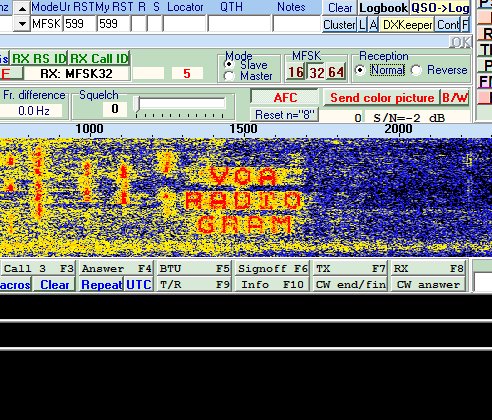 (Source: VOA Radiogram/Kim Elliott)
(Source: VOA Radiogram/Kim Elliott)
VOA Radiogram, 20-21 May 2017: Special doomed edition
I will retire from the Voice of America on June 23, after 32 years as audience research analyst and broadcaster.
I was hoping to continue to produce VOA Radiogram as a contractor. I approached various BBG and VOA offices. They all declined.
And, therefore, the last VOA Radiogram will be the weekend on June 17-18
Money is not the issue. I am willing to work cheap. My main interest is to be authorized to continue the show and maintain a VOA email address, so that I can keep in contact with the audience.
The irony is that, after retirement, I will finally have time to answer your emails – but I will no longer have access to the VOA email system to do that.
But, the show must go on. In addition to the four weekly transmissions via the BBG North Carolina transmitting site, VOA Radiogram is also broadcast on WRMI in Florida twice on Sundays. I can hardly allow those half-hour slots to be filled by light recorded music. So, beginning the weekend of June 24-25, a program similar to VOA Radiogram, but with a new name and email address, will be broadcast by WRMI.
More about the demise of VOA Radiogram, and the emergence of its replacement, in the weeks to come.

If they want to send digital info. via short wave, then why don’t they simply utilize the data capacity of DRM in the first place?(after all DRM is quite efficient at that .) Another attempt to re-invent the wheel?
Don’t believe the hype from DRM consortium and receiver manufacturers. The last years have taught me to exercise a strict “I believe it when I see it” policy. Modes used by Radiogram are far more robust than DRM(I have received both so I know where I am coming from) and software easily exists to decode them since ham radio operators use them too. Also, Radiogram is essentially data over AM – you can use an AM receiver to hear the tones, and decode them with software either via an audio patch or acoustic coupling. Not the case with DRM which entirely needs either a special receiver or an SDR or an access to radio’s IF. IIRC there were a few EasyPal(version of DRM adapted for ham radio) tests a few years ago but they weren’t as successful.
I love DRM as technology but the hype around it is too much.
The concept is a good, cheap alternative to the much superior DRM standard. Personally, I don’t mind its continuance alongside DRM. The radiogram initiative needs a better codec (research should continue) and dedicated hardware or hardware similar to the Titus 2. Flexibility in connecting a display, e.g. HDMI, is essential for these digital initiatives. I’d love to hear and read digital information via shortwave on my home theater with its projected display. I commend the originator of this concept for his willingness to continue the project.